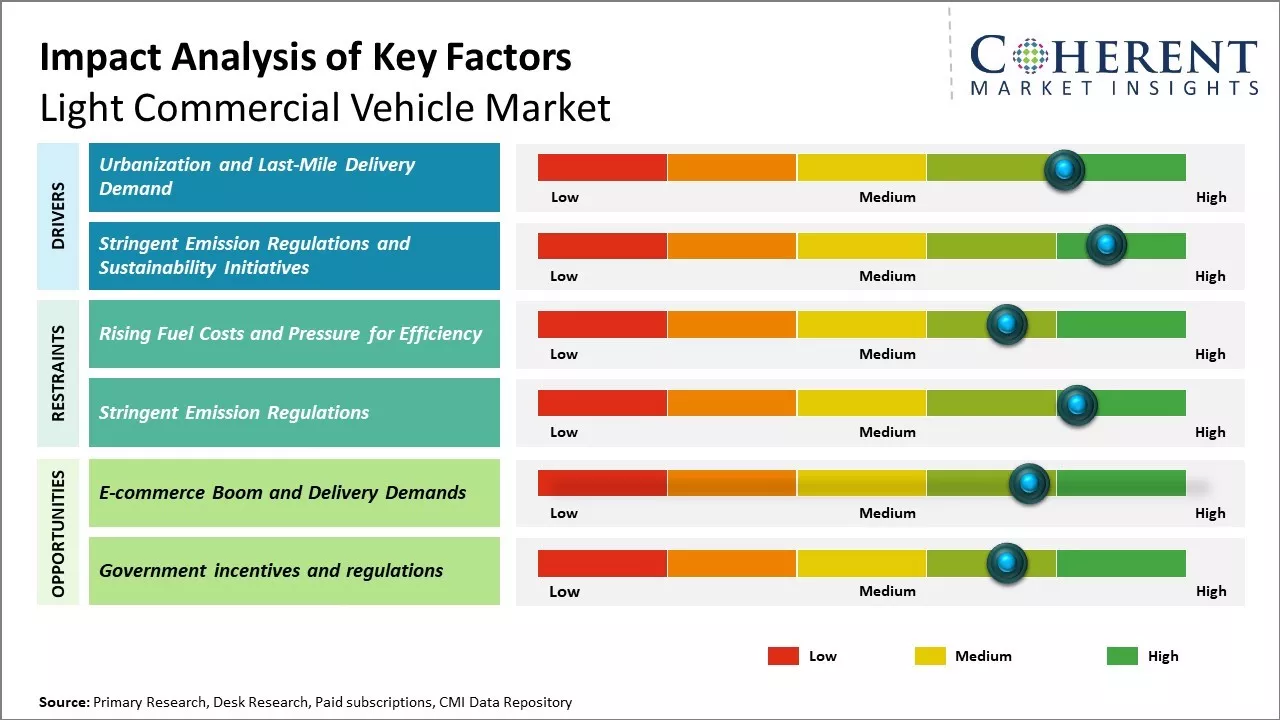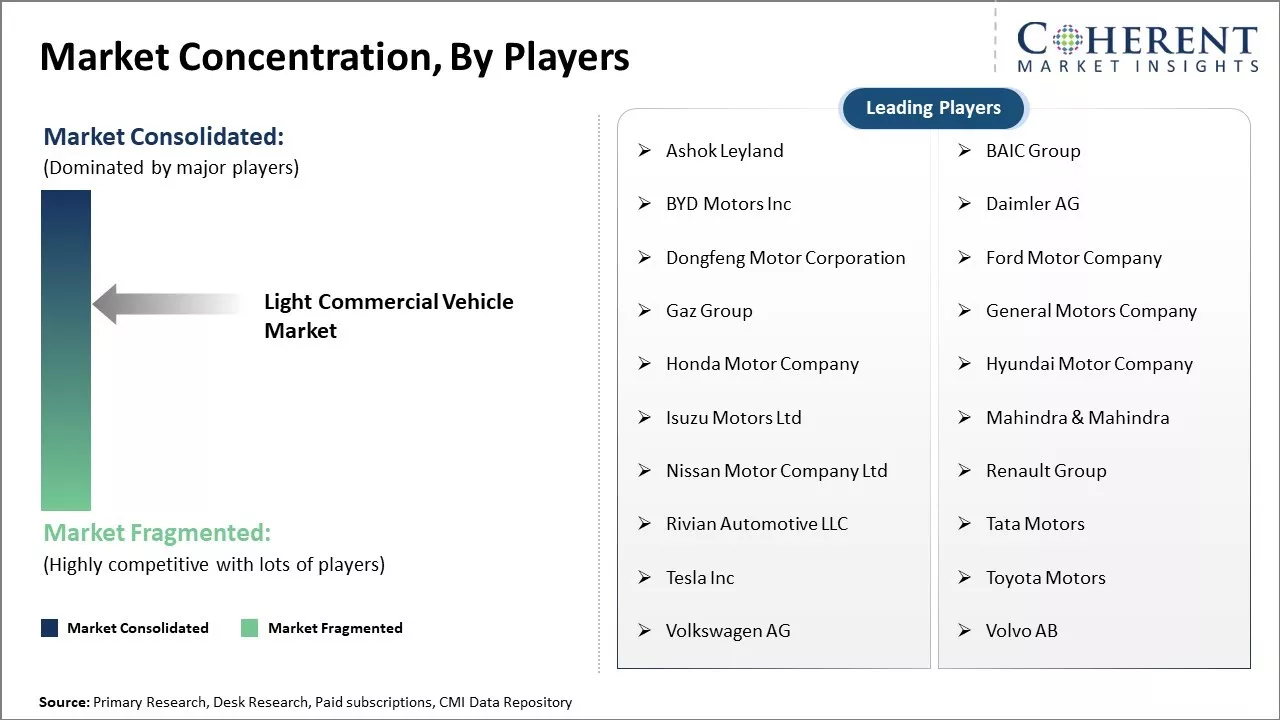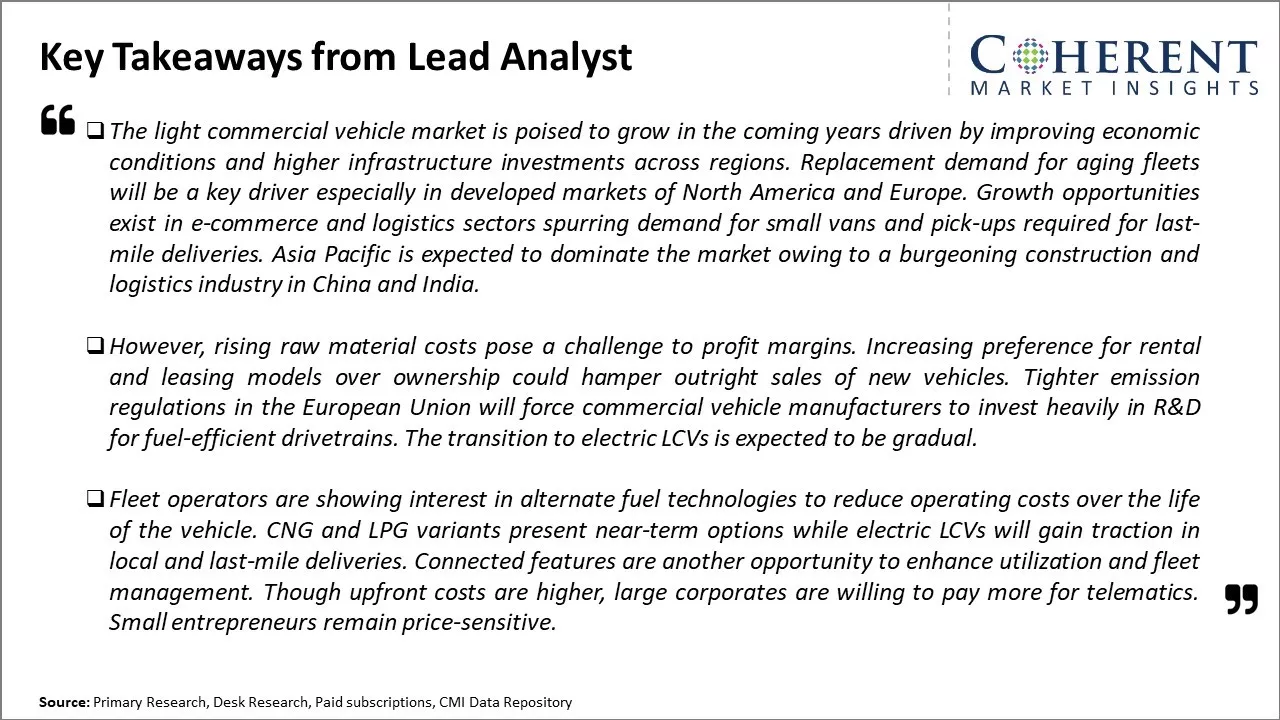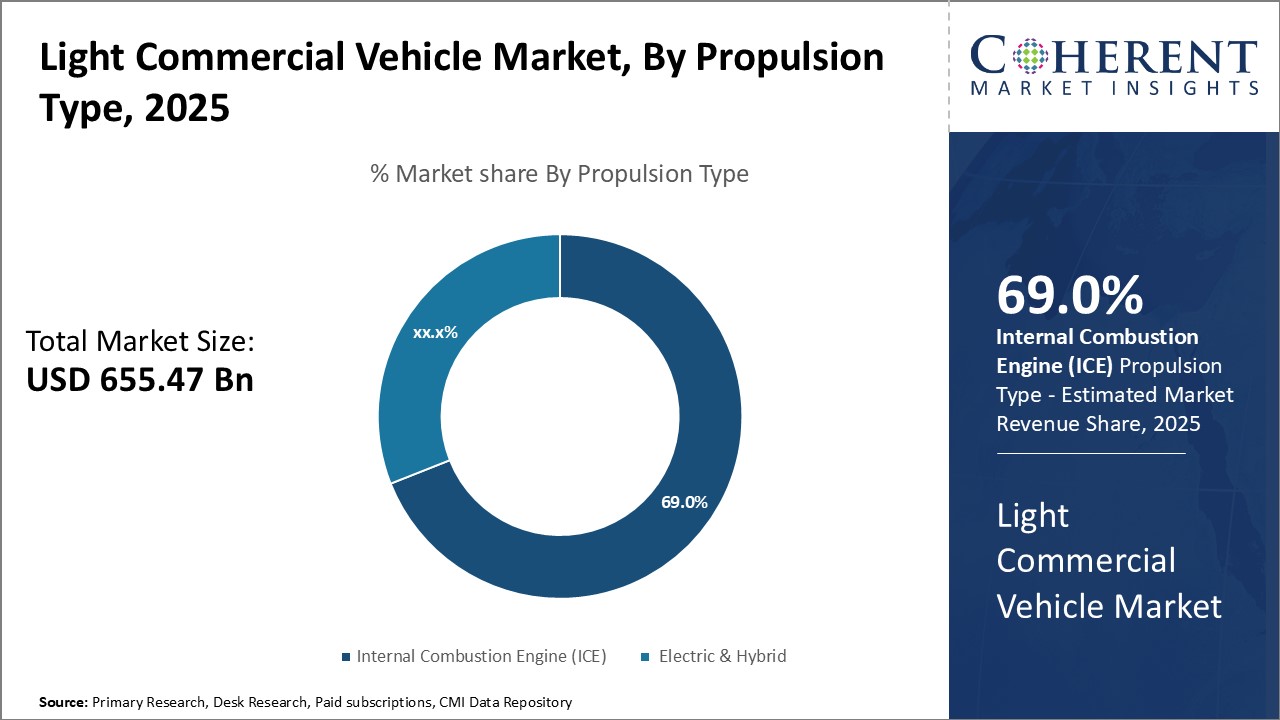Global light commercial vehicle market is estimated to be valued at US$ 655.47 Billion in 2025 and is expected to reach US$ 1,053.23 Billion by 2032, exhibiting a compound annual growth rate (CAGR) of 7.0% from 2025 to 2032.

Discover market dynamics shaping the industry: Request sample copy
Global light commercial vehicle market growth is driven by rising demand for last-mile deliveries and increasing preference for rental and shared mobility services. Major fleet operators are increasingly procuring light commercial vehicles to support their delivery and logistic services, owing to growing e-commerce sales. Furthermore, increasing number of small businesses are also relying on light commercial vehicles to transport goods. Factors such as rising urbanization, growing business activities, and expansion of logistics and transportation infrastructure boosts demand for light commercial vehicles over the forecast period.
Urbanization and Last-Mile Delivery Demand
As urbanization continues to accelerate globally, there is a growing demand for efficient last-mile delivery solutions. Light commercial vehicles are pivotal in fulfilling this demand, serving as the backbone for logistics and e-commerce companies to deliver goods directly to consumers. The rise of online shopping and same-day delivery expectations further amplifies the need for nimble and versatile LCVs that can navigate urban environments efficiently. The demand for light commercial vehicles is expected to surge as companies seek to optimize their delivery operations in densely populated areas.
For instance, in April 2021, DHL Express made a significant move towards electrifying its last-mile deliveries in Europe by purchasing 100 E-Ducato electric vans from Fiat

Get actionable strategies to beat competition: Request sample copy
Stringent Emission Regulations and Sustainability InitiativesGovernments worldwide are implementing stringent emissions regulations to combat air pollution and reduce greenhouse gas emissions. In response, manufacturers are compelled to develop cleaner and more fuel-efficient vehicles, including light commercial vehicles. This drive towards sustainability is pushing the adoption of electric and alternative fuel-powered LCVs. Businesses are increasingly embracing corporate social responsibility (CSR) initiatives, opting for eco-friendly transportation solutions to align with their sustainability goals. Light commercial vehicle market is experiencing a shift towards greener technologies, driving innovation and investment in electric and hybrid LCVs.
For instance, in November 2022, Ashok Leyland, a prominent commercial vehicle manufacturer under the Hinduja Group, announced its plan to bolster its market share in the electric vehicle sector. Executive chairman Dheeraj Hinduja outlined the company's EV roadmap, BS VI phase-2 readiness, and risk mitigation strategies during discussions with Shine Jacob.

To learn more about this report, Request sample copy
Market Challenges: Rising Fuel Costs and Pressure for EfficiencyCustomers want cars that use less fuel to help deal with higher fuel prices. Tough rules about emissions are causing problems for carmakers, both technically and financially. More companies, both local and from other countries, are joining the market with newer and better products. This means existing companies have to work faster to make new cars and improve how they make them to keep their customers.
Market Opportunities: E-commerce Boom and Delivery Demands
The increasing popularity of online shopping and the need for efficient delivery services are driving up the demand for small delivery vehicles. Thanks to improvements in battery and engine technologies, fully-electric delivery vehicles with longer ranges are now possible. Government incentives and rules are pushing for cleaner transportation options, encouraging businesses to invest in eco-friendly solutions. New types of delivery services, like those focused on the last leg of delivery, are becoming more common. By teaming up with other companies, businesses can broaden their range of services, especially in areas like digital connectivity.

Discover high revenue pocket segments and roadmap to it: Request sample copy
Insights, By Propulsion Type, Internal combustion engine propulsion is the dominant segment in light commercial vehicle marketBy propulsion type, internal combustion engine (ICE) segment is estimated to contribute the highest market share of 69.0% in 2025, owing to their widespread use and established infrastructure for refuelling. ICE vehicles have dominated the light commercial vehicle landscape for decades due to advantages in fuel efficiency and cargo capacities that suit the daily operation requirements of small businesses and logistics companies.
The development and rollout of gas stations across the world have made ICE fuels readily available even in remote locations, alleviating range anxiety concerns for commercial vehicle owners. Affordable ICE repairs and extensive aftermarket for spare parts has provided these vehicles high reliability.
Insights, By Vehicle Class, Class 2 (6,001-10,000 lbs) is the dominant segment light commercial vehicle market
By vehicle class, class 2 delivery trucks in the 6,001-10,000 lbs category segment is estimated to contribute the highest share of 72.63% in 2025. These mid-duty trucks offer Goldilocks payloads that strike the right balance of cargo capacity without sacrificing manoeuvrability required for last-mile services.
Their dimensions allow efficient multi-stop routes within urban environments. Comparatively lower purchase prices than heavier Class 3 or Class 4 trucks also improve earnings potential per vehicle. Flexible cargo areas accommodate various delivery configurations from consolidated parcel to refrigerated loads. Growing e-commerce has exponentially increased the need for last-mile and same-day delivery services, benefitting Class 2 truck sales.

Need a Different Region or Segment? Customize now
The light commercial vehicle market is poised for significant growth in Asia Pacific, dominating the global landscape with market share of 49.2% in 2025. This dominance is further amplified by the region's anticipated highest compound annual growth rate (CAGR) of 12.32% for 2025.
Asia Pacific is experiencing rapid economic expansion, particularly in countries like China. This translates to increased demand for goods and services, leading to a surge in LCV usage for last-mile delivery and urban transportation. Government initiatives in the region actively promote domestic production and technological advancements within the LCV industry. This fosters a robust ecosystem that caters to the growing demand.
Furthermore, the booming e-commerce sector in Asia Pacific heavily relies on LCVs for efficient delivery operations. The high population density and rapid urbanization in major cities also create a need for manoeuvrable and compact LCVs to navigate congested streets. These factors combined contribute to the significant and sustained growth of the LCV market in the region.
Light Commercial Vehicle Market Report Coverage
| Report Coverage | Details | ||
|---|---|---|---|
| Base Year: | 2024 | Market Size in 2025: | USD 655.47 Bn |
| Historical Data for: | 2020 To 2024 | Forecast Period: | 2025 To 2032 |
| Forecast Period 2025 to 2032 CAGR: | 7.0% | 2032 Value Projection: | USD 1,053.23 Bn |
| Geographies covered: |
|
||
| Segments covered: |
|
||
| Companies covered: |
Ashok Leyland, BAIC Group, BYD Motors Inc, Daimler AG, Dongfeng Motor Corporation, Ford Motor Company, Gaz Group, General Motors Company, Honda Motor Company, Hyundai Motor Company, Isuzu Motors Ltd, Mahindra & Mahindra, Nissan Motor Company Ltd, Renault Group, Rivian Automotive LLC, Tata Motors, Tesla Inc, Toyota Motors, Volkswagen AG, Volvo AB |
||
| Growth Drivers: |
|
||
| Restraints & Challenges: |
|
||
Uncover macros and micros vetted on 75+ parameters: Get instant access to report
Share
Share
About Author
Gautam Mahajan is a Research Consultant with 5+ years of experience in market research and consulting. He excels in analyzing market engineering, market trends, competitive landscapes, and technological developments. He specializes in both primary and secondary research, as well as strategic consulting across diverse sectors.
Missing comfort of reading report in your local language? Find your preferred language :
Transform your Strategy with Exclusive Trending Reports :
Frequently Asked Questions
Joining thousands of companies around the world committed to making the Excellent Business Solutions.
View All Our Clients
US Reciprocal Tax Impact Analysis On Light Commercial Vehicle Market
Stay updated on tariff changes with expert insights and timely information